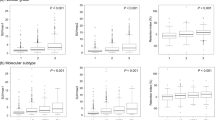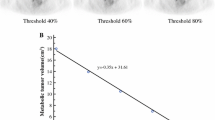Abstract
Objectives
To prospectively compare performances of single-voxel proton magnetic resonance spectroscopy (1H-MRS) and 18F-fluorodeoxyglucose positron emission tomography (FDG-PET) in predicting pathologic response to neoadjuvant chemotherapy (NAC) in breast cancer patients.
Methods
Thirty-five breast cancer patients who received NAC and subsequent surgery were prospectively enrolled. MRS and FDG-PET were performed before and after the 1st NAC cycle. Percentage changes of total choline-containing compounds (tCho) via MRS, and maximum and peak standardized uptake values (SUVmax, SUVpeak) and total lesion glycolysis (TLG) via FDG-PET were measured, and their performances in predicting pathologic complete response (pCR) were compared.
Results
Of the 35 patients, 6 showed pCR and 29 showed non-pCR. Mean % reductions of tCho, SUVmax, SUVpeak, and TLG of the pCR group were larger than those of the non-pCR group (-80.3 ± 13.9 % vs. -32.1 ± 49.4 %, P = 0.025; -54.7 ± 22.1 % vs. -26.3 ± 33.7 %, P = 0.058; -60.7 ± 18.3 % vs. -32.3 ± 23.3 %, P = 0.009; -89.5 ± 8.5 % vs. -52.6 ± 36.2 %, P = 0.020). Diagnostic accuracy (area under ROC curve; Az, 0.911) of the % reduction of tCho was comparable to those of %SUVmax (0.822), SUVpeak (0.862), and TLG (0.879) in distinguishing pCR from non-pCR (all P > 0.05).
Conclusion
MRS showed comparable performance to FDG-PET in early prediction of pCR in breast cancer patients.
Key points
• MRS can predict response to NAC in breast cancer post-1 st cycle.
• Changes in tCho and SUV after NAC reflect tumour cellularity changes.
• MRS can be an alternative to FDG-PET in predicting response to NAC.





Similar content being viewed by others
Abbreviations
- NAC:
-
Neoadjuvant chemotherapy
- H-MRS:
-
Proton magnetic resonance spectroscopy
- FDG-PET:
-
18F- fluorodeoxyglucose positron emission tomography
- pCR:
-
Pathologic complete response
- MRI:
-
Magnetic resonance imaging
- tCho:
-
Total choline-containing compounds
- SUV:
-
Standardized uptake value
- TLG:
-
Total lesion glycolysis
References
Chia S, Swain SM, Byrd DR et al (2008) Locally advanced and inflammatory breast cancer. J Clin Oncol 26:786–790
Buchholz TA, Lehman CD, Harris JR et al (2008) Statement of the science concerning locoregional treatments after preoperative chemotherapy for breast cancer: a National Cancer Institute Conference. J Clin Oncol 26:791–797
Von Minckwitz G, Kaufmann M, Kuemmel S, for the GBG and AGO-B Study Groups et al (2011) Correlation of various pathologic complete response (pCR) definitions with long-term outcome and the prognostic value of pCR in various breast cancer subtypes: results from the German neoadjuvant meta-analysis. J Clin Oncol 29:1028
Kaufmann M, von Minckwitz G, Mamounas EP et al (2012) Recommendations from an international consensus conference on the current status and future of neoadjuvant systemic therapy in primary breast cancer. Ann Surg Oncol 19:1508–1516
von Minckwitz G, Blohmer JU, Costa SD et al (2013) Response-guided neoadjuvant chemotherapy for breast cancer. J Clin Oncol 31:3623–3630
Hylton NM, Blume JD, Bernreuter WK et al (2012) Locally advanced breast cancer: MR imaging for prediction of response to neoadjuvant chemotherapy--results from ACRIN 6657/I-SPY TRIAL. Radiology 263:663–672
Rieber A, Brambs HJ, Gabelmann A, Heilmann V, Kreienberg R, Kuhn T (2002) Breast MRI for monitoring response of primary breast cancer to neoadjuvant chemotherapy. Eur Radiol 12:1711–1719
Rousseau C, Devillers A, Sagan C et al (2006) Monitoring of early response to neoadjuvant chemotherapy in stage II and III breast cancer by [18F]fluorodeoxyglucose positron emission tomography. J Clin Oncol 24:5366–5372
Schwarz-Dose J, Untch M, Tiling R et al (2009) Monitoring primary systemic therapy of large and locally advanced breast cancer by using sequential positron emission tomography imaging with [18F]fluorodeoxyglucose. J Clin Oncol 27:535–541
Meisamy S, Bolan PJ, Baker EH et al (2004) Neoadjuvant chemotherapy of locally advanced breast cancer: predicting response with in vivo (1)H MR spectroscopy--a pilot study at 4 T. Radiology 233:424–431
Baek HM, Chen JH, Nie K et al (2009) Predicting pathologic response to neoadjuvant chemotherapy in breast cancer by using MR imaging and quantitative 1H MR spectroscopy. Radiology 251:653–662
Danishad KKA, Sharma U, Sah RG, Seenu V, Parshad R, Jagannathan NR (2010) Assessment of therapeutic response of locally advanced breast cancer (LABC) patients undergoing neoadjuvant chemotherapy (NACT) monitored using sequential magnetic resonance spectroscopic imaging (MRSI). NMR Biomed 23:233–241
Tozaki M, Sakamoto M, Oyama Y et al (2008) Monitoring of early response to neoadjuvant chemotherapy in breast cancer with (1)H MR spectroscopy: comparison to sequential 2-[18F]-fluorodeoxyglucose positron emission tomography. J Magn Reson Imaging 28:420–427
Cho N, Im SA, Park IA et al (2014) Breast cancer: early prediction of response to neoadjuvant chemotherapy using parametric response maps for MR imaging. Radiology 272:385–396
Tozaki M, Sakamoto M, Oyama Y, Maruyama K, Fukuma E (2010) Predicting pathological response to neoadjuvant chemotherapy in breast cancer with quantitative 1H MR spectroscopy using the external standard method. J Magn Reson Imaging 31:895–902
Wahl RL, Jacene H, Kasamon Y, Lodge MA (2009) From RECIST to PERCIST: evolving considerations for PET response criteria in solid tumors. J Nucl Med 50(Suppl 1):122S–150S
Lopci E, Zucali PA, Ceresoli GL et al (2015) Quantitative analyses at baseline and interim PET evaluation for response assessment and outcome definition in patients with malignant pleural mesothelioma. Eur J Nucl Med Mol Imaging 42:667–675
Im HJ, Kim YK, Kim YI, Lee JJ, Lee WW, Kim SE (2013) Usefulness of combined metabolic-volumetric indices of (18)F-FDG PET/CT for the early prediction of neoadjuvant chemotherapy outcomes in breast cancer. Nucl Med Mol Imaging 47:36–43
Ogston KN, Miller ID, Payne S et al (2003) A new histological grading system to assess response of breast cancers to primary chemotherapy: prognostic significance and survival. Breast 12:320–327
Silver DP, Richardson AL, Eklund AC et al (2010) Efficacy of neoadjuvant Cisplatin in triple-negative breast cancer. J Clin Oncol 28:1145–1153
Jung SY, Kim SK, Nam BH et al (2010) Prognostic impact of [18F] FDG-PET in operable breast cancer treated with neoadjuvant chemotherapy. Ann Surg Oncol 17:247–253
Connolly RM, Leal JP, Goetz MP et al (2015) TBCRC 008: early change in 18F-FDG uptake on PET predicts response to preoperative systemic therapy in human epidermal growth factor receptor 2-negative primary operable breast cancer. J Nucl Med 56:31–37
Ah-See ML, Makris A, Taylor NJ et al (2008) Early changes in functional dynamic magnetic resonance imaging predict for pathologic response to neoadjuvant chemotherapy in primary breast cancer. Clin Cancer Res 14:6580–6589
Li SP, Makris A, Beresford MJ et al (2011) Use of dynamic contrast-enhanced MR Imaging to predict survival in patients with primary breast cancer undergoing neoadjuvant chemotherapy. Radiology 260:68–78
Tateishi U, Miyake M, Nagaoka T et al (2012) Neoadjuvant chemotherapy in breast cancer: prediction of pathologic response with PET/CT and dynamic contrast-enhanced MR imaging--prospective assessment. Radiology 263:53–63
Pengel KE, Koolen BB, Loo CE et al (2014) Combined use of 18F-FDG PET/CT and MRI for response monitoring of breast cancer during neoadjuvant chemotherapy. Eur J Nucl Med Mol Imaging 41:1515–1524
Lim I, Noh WC, Park J et al (2014) The combination of FDG PET and dynamic contrast-enhanced MRI improves the prediction of disease-free survival in patients with advanced breast cancer after the first cycle of neoadjuvant chemotherapy. Eur J Nucl Med Mol Imaging 41:1852–1860
An YY, Kim SH, Kang BJ, Lee AW (2015) Treatment response evaluation of breast cancer after neoadjuvant chemotherapy and usefulness of the imaging parameters of MRI and PET/CT. J Korean Med Sci 30:808–815
Aboagye EO, Bhujwalla ZM (1999) Malignant transformation alters membrane choline phospholipid metabolism of human mammary epithelial cells. Cancer Res 59:80–84
Glunde K, Bhujwalla ZM, Ronen SM (2011) Choline metabolism in malignant transformation. Nat Rev Cancer 11:835–848
Kolesnikov-Gauthier H, Vanlemmens L, Baranzelli MC et al (2012) Predictive value of neoadjuvant chemotherapy failure in breast cancer using FDG-PET after the first course. Breast Cancer Res Treat 131:517–525
Young H, Baum R, Cremerius U et al (1999) Measurement of clinical and subclinical tumour response using [18F]-fluorodeoxyglucose and positron emission tomography: review and 1999 EORTC recommendations. European Organization for Research and Treatment of Cancer (EORTC) PET Study Group. Eur J Cancer 35:1773–1782
Begley JK, Redpath TW, Bolan PJ, Gilbert FJ (2012) In vivo proton magnetic resonance spectroscopy of breast cancer: a review of the literature. Breast Cancer Res 14:207
Sardanelli F, Fausto A, Di Leo G, de Nijs R, Vorbuchner M, Podo F (2009) In vivo proton MR spectroscopy of the breast using the total choline peak integral as a marker of malignancy. AJR Am J Roentgenol 192:1608–1617
Acknowledgments
The scientific guarantor of this publication is Woo Kyung Moon. The authors of this manuscript declare no relationships with any companies whose products or services may be related to the subject matter of the article. This research was supported by the Basic Science Research Program through the National Research Foundation of Korea (NRF) funded by the Ministry of Education (2014R1A1A2053682), and by a grant (no. 03-2014-0320) from the Seoul National University Hospital Research Fund, and the Korea Healthcare Technology R&D Project, Ministry of Health & Welfare, Republic of Korea (grant A070001). Some patients have been reported previously in Breast Cancer: Early Prediction of Response to Neoadjuvant Chemotherapy Using Parametric Response Maps for MR Imaging. Radiology 2014;272:385-396. No complex statistical methods were necessary for this paper. Institutional review board approval was obtained. Written informed consent was obtained from all subjects (patients) in this study. Methodology: prospective, diagnostic or prognostic study, performed at one institution.
Author information
Authors and Affiliations
Corresponding author
Rights and permissions
About this article
Cite this article
Cho, N., Im, SA., Kang, K.W. et al. Early prediction of response to neoadjuvant chemotherapy in breast cancer patients: comparison of single-voxel 1H-magnetic resonance spectroscopy and 18F-fluorodeoxyglucose positron emission tomography. Eur Radiol 26, 2279–2290 (2016). https://doi.org/10.1007/s00330-015-4014-7
Received:
Revised:
Accepted:
Published:
Issue Date:
DOI: https://doi.org/10.1007/s00330-015-4014-7




